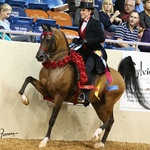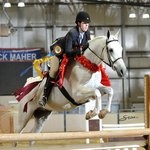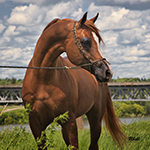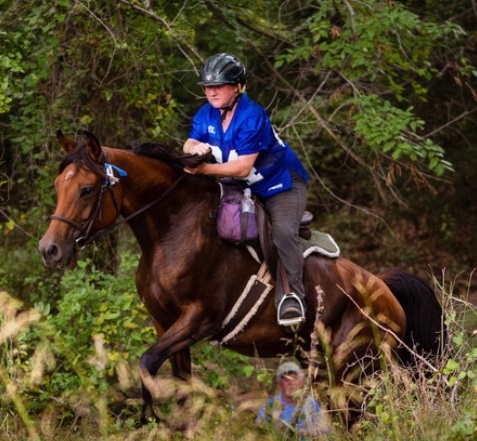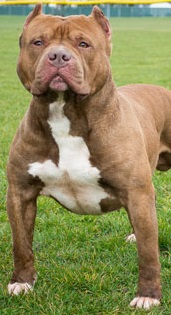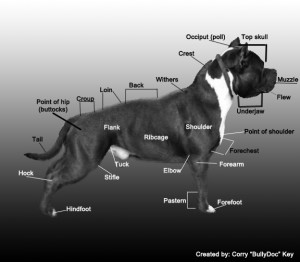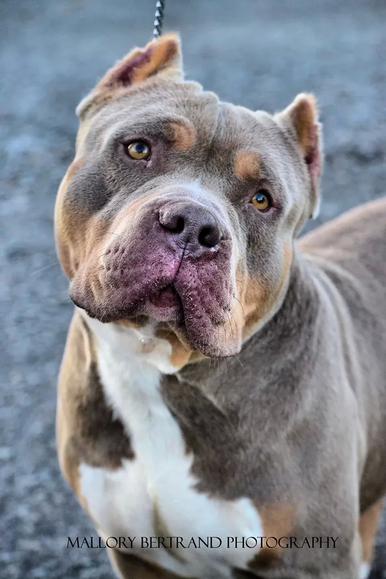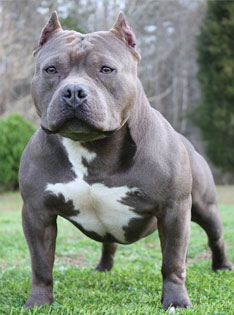What is Type?
 “Type is defined as the characteristics which make a breed recognizable
“Type is defined as the characteristics which make a breed recognizable
and distinctive from others.”
 Recently I had someone who said I couldn’t possibly know what I was talking about in regard to the American Bully because I bred Arabian horses. That spurred me to write this article.
Recently I had someone who said I couldn’t possibly know what I was talking about in regard to the American Bully because I bred Arabian horses. That spurred me to write this article.
 You see, the Arabian horse, which has been around for centuries, is a stark contrast to the world of the American Bully, still in its infancy in both structure and genetics. Arabian horse breeders have spent centuries trying to create the perfect example of the breed, per the standard; a standard that is very specific in its directives. However, like the American Bully, the Arabian has many “styles”, but at the end of the day, they are all recognizable as one breed.
You see, the Arabian horse, which has been around for centuries, is a stark contrast to the world of the American Bully, still in its infancy in both structure and genetics. Arabian horse breeders have spent centuries trying to create the perfect example of the breed, per the standard; a standard that is very specific in its directives. However, like the American Bully, the Arabian has many “styles”, but at the end of the day, they are all recognizable as one breed.
 With the American Bully, it is a bit more complex. What is an American Bully? I get this question a lot. And every time, I struggle with how to answer it.
With the American Bully, it is a bit more complex. What is an American Bully? I get this question a lot. And every time, I struggle with how to answer it.
 The American Bully has been accused of being many things. Bull dogs. Badly bred pit bulls. Selectively bred Am Staffs. Bandogges. Mastiffs. Genetic disasters. You name it. But at the end of the day, if American Bully breeders don’t come together and agree on what “type” is, this breed will continue on the path to extinction, at least as far as the standard is concerned.
The American Bully has been accused of being many things. Bull dogs. Badly bred pit bulls. Selectively bred Am Staffs. Bandogges. Mastiffs. Genetic disasters. You name it. But at the end of the day, if American Bully breeders don’t come together and agree on what “type” is, this breed will continue on the path to extinction, at least as far as the standard is concerned.
 Type is anything that makes that breed what it is. In the American Bully, the standard calls for a head that is “medium in length, deep throughout, broad skull, well chiseled with very pronounced cheek muscles, distinct and deep stop” and faults include “muzzle too long or snipey; muzzle so short as to interfere with normal breathing; lack of pronounced cheek and deep stop; weak under jaw; under jaw turning up; nose turning up or pushed back; excessive flews.” The neck should be “heavy, muscular, slightly arched, tapering from shoulder to back of skull. Compact to medium size, should have minimal or no loose skin.”
Type is anything that makes that breed what it is. In the American Bully, the standard calls for a head that is “medium in length, deep throughout, broad skull, well chiseled with very pronounced cheek muscles, distinct and deep stop” and faults include “muzzle too long or snipey; muzzle so short as to interfere with normal breathing; lack of pronounced cheek and deep stop; weak under jaw; under jaw turning up; nose turning up or pushed back; excessive flews.” The neck should be “heavy, muscular, slightly arched, tapering from shoulder to back of skull. Compact to medium size, should have minimal or no loose skin.”
So does this example match the standard as written?
 Shoulders should “be strong and muscular with blades set wide and well laid back. The upper arm is approximately equal to the length of the shoulder blade and joined at an angle of approximately 35 to 45 degrees” Fore legs should be “straight, strong, and sturdy with large...bones, pasterns are strong, short and nearly erect. Feet- straight forward.” Faults include “upright shoulders; steep and forward scapula (shoulder blade). Upper arm too short. Feet toeing either in or out; front legs bowed; down at the pasterns; splayed or flat feet; long toes.”
Shoulders should “be strong and muscular with blades set wide and well laid back. The upper arm is approximately equal to the length of the shoulder blade and joined at an angle of approximately 35 to 45 degrees” Fore legs should be “straight, strong, and sturdy with large...bones, pasterns are strong, short and nearly erect. Feet- straight forward.” Faults include “upright shoulders; steep and forward scapula (shoulder blade). Upper arm too short. Feet toeing either in or out; front legs bowed; down at the pasterns; splayed or flat feet; long toes.”
 Body should be “heavily muscled, massive bulky body type of
Body should be “heavily muscled, massive bulky body type of
compact/medium length giving the impression of great power for its size”
and chest “should be broad, deep, and well filled in; but should not be
exaggerated as to interfere with normal movement.” Faults in the body
should include “Back too long; rear higher than withers; weak or swayed
topline; roached or wheel back.” These are faults that are consistently
being bred within this breed.
 Hindquarters are to be “well muscled, let down at hocks, turning neither in nor out. Muscular development, angulation and width of the hindquarters should be in balance with that of the forequarters.” Faults are “hocks turning in or out; cow hocks; sickle hocks; narrow hindquarters; straight or over-angulated stifle joints; bowed legs.”
Hindquarters are to be “well muscled, let down at hocks, turning neither in nor out. Muscular development, angulation and width of the hindquarters should be in balance with that of the forequarters.” Faults are “hocks turning in or out; cow hocks; sickle hocks; narrow hindquarters; straight or over-angulated stifle joints; bowed legs.”
The tail faults include “Tail to long or too short (approximately up to an inch above or below point of the hock.) Gay tail (carried over the plane of the back). Serious Faults: Kinked, knotted, or fused tail. Extremely short tail. Disqualifying Faults: Screwed, bobbed, or docked tail.”
 So the elements of “type” in the American Bully are multi-faceted and include more than just head shape. 1.)Head/neck, 2.) shoulders/forearm, 3.) Body/back, 4.) Hindquarters/tail. These qualities all come together to give us what we recognize as true breed type. If you become kennel blind to what breed type truly means, you lose the meaning of breed type. If you concentrate on one, forsaking the others, you lose the essential elements of a breed. And when that happens, the breed becomes extinct.
So the elements of “type” in the American Bully are multi-faceted and include more than just head shape. 1.)Head/neck, 2.) shoulders/forearm, 3.) Body/back, 4.) Hindquarters/tail. These qualities all come together to give us what we recognize as true breed type. If you become kennel blind to what breed type truly means, you lose the meaning of breed type. If you concentrate on one, forsaking the others, you lose the essential elements of a breed. And when that happens, the breed becomes extinct.

